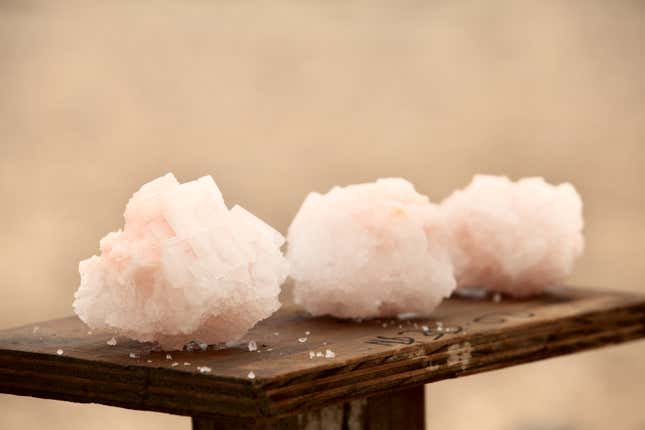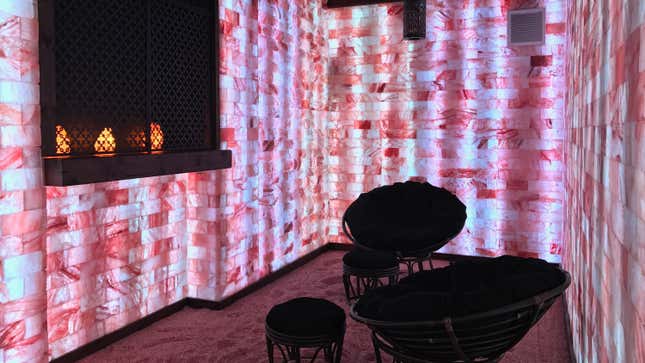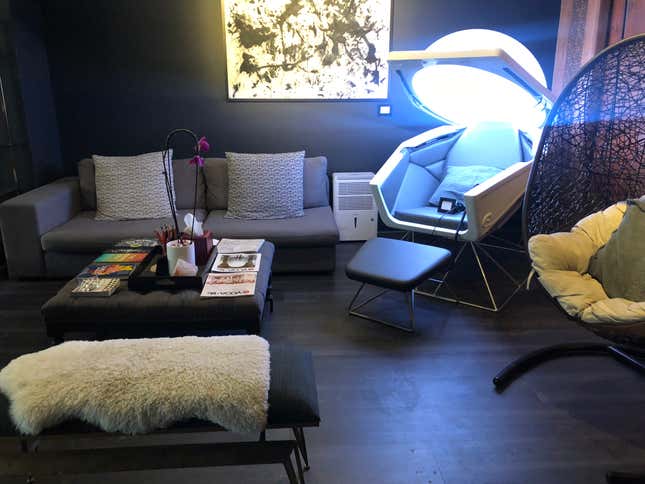Journey to the Pink Heart of a Salt Cave, a Wellness Trend You Can Breathe
Latest

On the ninth floor of an unremarkable building in NoMad near SoulCycle, Sweetgreen, and an aggressively pink cafe named Cha Cha Matcha, is one of the only rooms in Manhattan made entirely of Himalayan salt.
Located in the luxury spa Modrn Sanctuary, it is designed to mimic a salt cave, though it looks more like a millennial pink igloo, with walls of hand-cut bricks and a heated floor covered in coarse, granulated salt. The salinated air comes from crushed, medical-grade salt, according to owner Alexandra Janelli, which blasts from a generator into the room for every 30-minute session. LED lights positioned within are meant to be therapeutic, hypothetically making the salt room a cure for all your basic ailments, whether respiratory problems, a common cold, allergies, sleep problems, eczema, or migraine headaches. More concretely, it’s not a bad way to decompress, even if you’re not suffering from anything in particular.
As a treatment for respiratory or skin problems, halotherapy—the act of breathing in salt air for health benefits—has not been FDA approved in the United States, though the number of salt rooms in the U.S. has ballooned from roughly 10 to more than 300, over a five-year period. Halotherapy, according to its proponents, works by mimicking the dry and salty conditions inside of salt caves; it’s a subset of climatotherapy, which is grounded in the belief that traveling to distinct climates—thermal springs, Icelandic lagoons, the Dead Sea—can relieve symptoms of irritating and difficult-to-manage conditions. Studies have shown climatotherapy at the Dead Sea can be an effective treatment for psoriasis—but for those who can’t travel halfway around the world, climatotherapy is accessible at spas, resorts, and “wellness” centers like Modrn Sanctuary.
Which makes sense: In the last decade, salt has increasingly become a signifier of luxury. Pink Himalayan salt entered the Trader Joe’s aisles in 2009, and has never left; salt scrubs have hit the level of ubiquity that if you search the term on Pinterest, you’d never run out of results to scroll through; and along with light therapy lamps and sunrise alarm clocks, Himalayan salt lamps reached peak trend last year, sold as an aid for sound sleep. (Almost all salt-related wellness trends involve Himalayan salt, which is mined from the mountains in Pakistan, and stem from the idea that because such salt comes from the ground, untouched by civilization, it must be purer than your regular table salt. There’s little evidence to support this.)

Janelli, who now lives in Philadelphia and works remotely, used to do salt therapy every day when she lived in New York. “I used to take business meetings in there,” she told Jezebel. She decided to take over Modrn after visiting the Montauk Salt Cave and noticing that her boyfriend at the time, who suffered from allergies, started to feel better. Janelli is used to skeptics, though. “Acupuncture was poo-poo’d for so long, so was reiki,” she said. “So was hypnosis, and now you’re seeing them become more standard in hospitals.”
“We always say, ‘Come and just try it,’” she added. “Whether it’s the placebo effect or not, it almost doesn’t matter.”
“WE ALWAYS SAY, ‘COME AND JUST TRY IT. WHETHER IT’S THE PLACEBO EFFECT OR NOT, IT ALMOST DOESN’T MATTER.”
Salt does have anti-inflammatory properties, and can be a useful in treating certain conditions—saline nasal spray is regularly used to relieve congestion, for instance. But there hasn’t been enough research on halotherapy to prove much of anything: A meta-review of 151 halotherapy-related studies found that only one met the basic criteria for a high-quality scientific analysis.
“The scientific community is not exactly sure why halotherapy might be helpful,” Dr. Payel Gupta, a spokesperson for the American Lung Association, told Jezebel. “Tiny salt particles might be killing off harmful microorganisms in the lungs, or [it could be] there’s a reduction in inflammation and decrease in mucus,” which would make breathing easier for patients with conditions like chronic obstructive pulmonary disorder (COPD), asthma, or cystic fibrosis.
But what about for me, I asked Gupta, a person with no serious, persistent health problems beyond the expected amount of anxiety for a 27-year-old woman working in media?
“Maybe you’d notice your nasal passageways are more open after a session,” Gupta responded, though cautioned that, because the climate inside salt chambers isn’t FDA-regulated, some could harbor a motley of fun bacteria and mold that might aggravate symptoms for people with asthma.
As a lifelong sufferer of sinus issues, I wondered if a stay in a salt room might actually soothe my perennially aching schnoz, or if I would even be able to tell if it was doing anything at all.
Modrn is designed to make you feel like you’re in a sensory deprivation tank. “I got a lot of shit for doing the walls really dark,” Janelli said, laughing. The reception area is painted black, with dark wooden floors and a large set of Balinese doors. The couches and other décor were mostly purples and grays, accented in soft off-white; a giant, glowing meditation pod in the corner looked like a futuristic, floating egg from a movie. The goal of the boho-goth color scheme, according to Janelli, is to make it easier to relax. “I wanted the space to feel like you were walking into someone’s home,” she said.

The receptionist, who I had trouble seeing against the strong late afternoon light coming in from the window behind her, was supremely sweet and offered me a water when I arrived for my session. I noticed chocolates being sold to my right and a number of beauty products lining shelves along a wall; one looked like a mortar and pestle made of pink Himalayan salt.
Janelli had instructed me to come to my session wearing whatever made me comfortable, but mentioned I might notice salty particles clinging to my clothes if I wore anything black. Two other women were already in the salt room, barefoot; I sat down in a plush oversized chair, and when I leaned all the way back, I was almost horizontal. It was dead silent—when I wiggled around to take my phone out of my pocket, the only sound was my chair squeaking.
The receptionist told us to enjoy our session and closed the door. A whirring began. I didn’t see any of the salty air being sprayed into the room, and I couldn’t smell anything, though briefly wondered if I was just too stuffed up to detect it. The room was barely big enough for the three of us—and it occurred to me that we were engaging in three separate experiences that were each meant to be solitary, rather than one meditative, communal experience, more like riding the bus than taking a yoga class. We sat in total silence for 30 minutes. I noticed there was a tissue box on a mantle in front of me and wondered if people had cried here. Occasionally, I tuned back into the whirring of the salt machine, but I didn’t notice anything different about my breathing.
I noticed there was a tissue box on a mantle in front of me and wondered if people had cried here.
That night, I slept normally, although I already use a daily nasal spray that my doctor prescribed a few months ago for my sleep problems. (Dr. Gupta told me I could potentially achieve the same benefits of sitting in a salt room with an over-the-counter nasal spray.) It occurred to me that those who swear by halotherapy for problems like colds or migraines might just tell me to try again. Salt rooms, like other alternative therapies, are almost never packaged or sold as one-time experiences; the idea is that, to reap the benefits, you must suspend your disbelief long enough to attempt it multiple times.
While relaxing in the salt room was deeply pleasant, I also felt like my visit was a wellness experience between three strangers who did not necessarily want to share it. If we were paying to get away from everyone else, never mind the purported health benefits, we were only getting a third of our money’s worth. I thought about the value of forcing yourself to sit in a room and do nothing, which to me ended up being halotherapy’s biggest draw; Janelli told me she tried a no-phones rule at first, but it didn’t stick. People love Instagramming the salt room.